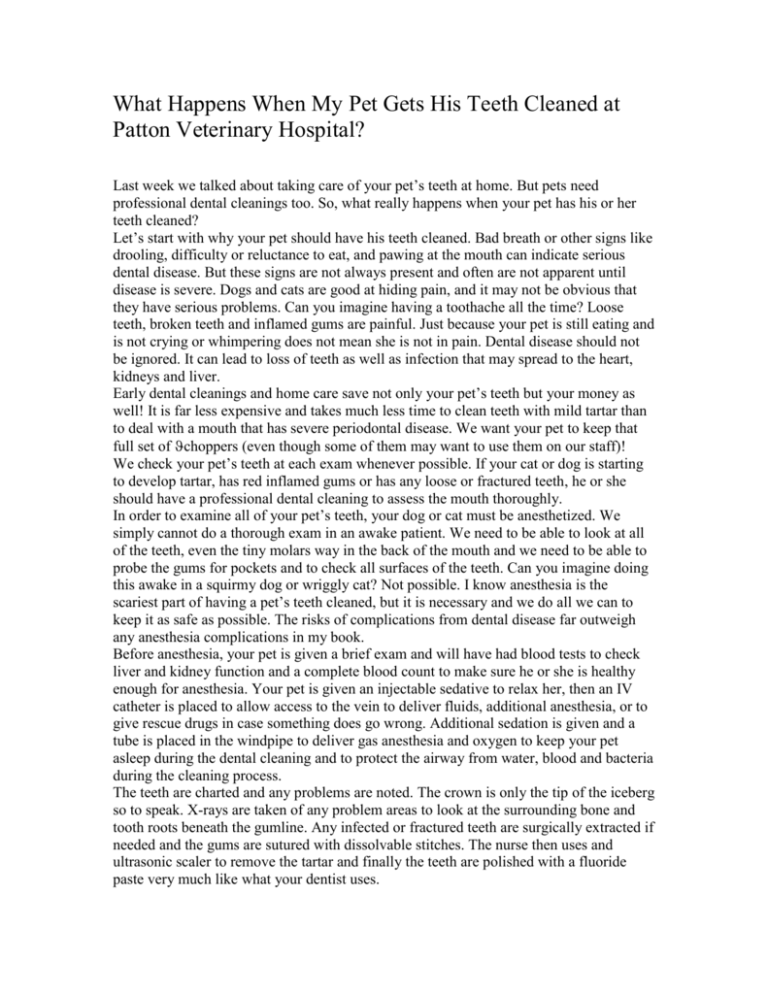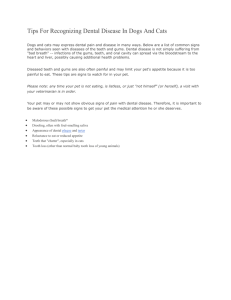What happens at my pets dental?
advertisement

What Happens When My Pet Gets His Teeth Cleaned at Patton Veterinary Hospital? Last week we talked about taking care of your pet’s teeth at home. But pets need professional dental cleanings too. So, what really happens when your pet has his or her teeth cleaned? Let’s start with why your pet should have his teeth cleaned. Bad breath or other signs like drooling, difficulty or reluctance to eat, and pawing at the mouth can indicate serious dental disease. But these signs are not always present and often are not apparent until disease is severe. Dogs and cats are good at hiding pain, and it may not be obvious that they have serious problems. Can you imagine having a toothache all the time? Loose teeth, broken teeth and inflamed gums are painful. Just because your pet is still eating and is not crying or whimpering does not mean she is not in pain. Dental disease should not be ignored. It can lead to loss of teeth as well as infection that may spread to the heart, kidneys and liver. Early dental cleanings and home care save not only your pet’s teeth but your money as well! It is far less expensive and takes much less time to clean teeth with mild tartar than to deal with a mouth that has severe periodontal disease. We want your pet to keep that full set of choppers (even though some of them may want to use them on our staff)! We check your pet’s teeth at each exam whenever possible. If your cat or dog is starting to develop tartar, has red inflamed gums or has any loose or fractured teeth, he or she should have a professional dental cleaning to assess the mouth thoroughly. In order to examine all of your pet’s teeth, your dog or cat must be anesthetized. We simply cannot do a thorough exam in an awake patient. We need to be able to look at all of the teeth, even the tiny molars way in the back of the mouth and we need to be able to probe the gums for pockets and to check all surfaces of the teeth. Can you imagine doing this awake in a squirmy dog or wriggly cat? Not possible. I know anesthesia is the scariest part of having a pet’s teeth cleaned, but it is necessary and we do all we can to keep it as safe as possible. The risks of complications from dental disease far outweigh any anesthesia complications in my book. Before anesthesia, your pet is given a brief exam and will have had blood tests to check liver and kidney function and a complete blood count to make sure he or she is healthy enough for anesthesia. Your pet is given an injectable sedative to relax her, then an IV catheter is placed to allow access to the vein to deliver fluids, additional anesthesia, or to give rescue drugs in case something does go wrong. Additional sedation is given and a tube is placed in the windpipe to deliver gas anesthesia and oxygen to keep your pet asleep during the dental cleaning and to protect the airway from water, blood and bacteria during the cleaning process. The teeth are charted and any problems are noted. The crown is only the tip of the iceberg so to speak. X-rays are taken of any problem areas to look at the surrounding bone and tooth roots beneath the gumline. Any infected or fractured teeth are surgically extracted if needed and the gums are sutured with dissolvable stitches. The nurse then uses and ultrasonic scaler to remove the tartar and finally the teeth are polished with a fluoride paste very much like what your dentist uses. Trust me, doctors hate pulling teeth, but in many cases, surgical extraction is in the best interest of the pet to remove painful, fractured, loose or infected teeth. We only take a tooth if it is absolutely necessary. Surgical extractions are difficult and we want your pet to keep those teeth, but we also know it makes no sense to leave a bad tooth in the mouth. It will only continue to cause problems in the future. So, there you have it. The mystery of a dental cleaning revealed. Once the teeth have been cleaned continuing dental care at home is very important to continue to keep your pet’s mouth healthy. Let’s work together to keep bright shiny smiles for all our cats and dogs!






